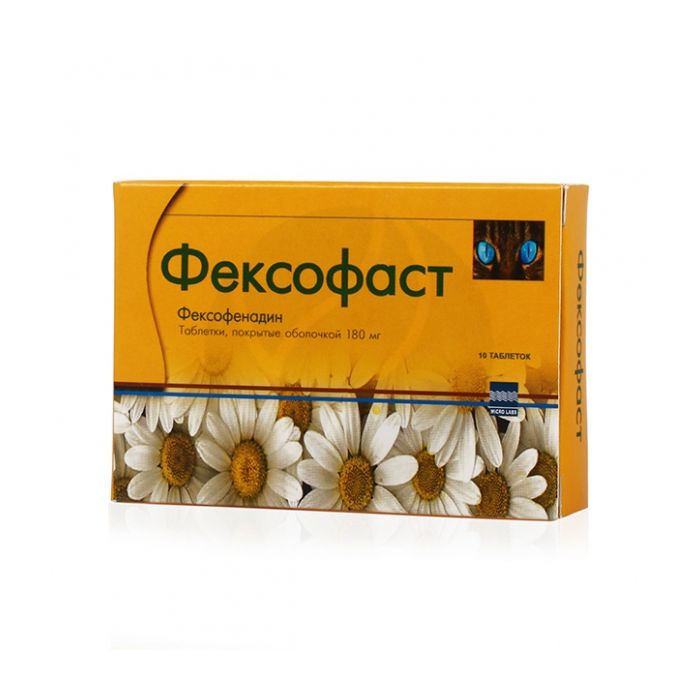Fexofast tablets 180mg, No. 10
Expiration Date: 05/2027
Russian Pharmacy name:
Фексофаст таблетки 180мг, №10
Seasonal allergic rhinitis, chronic urticaria.
Inside.
For seasonal allergic rhinitis, adults and children over 12 years old, 120 mg once a day.
For chronic urticaria , 180 mg once a day.
Active ingredient: fexofenadine 180 mg.
Excipients: microcrystalline cellulose - 43,500 mg, starch - 60,000 mg, lactose - 159,000 mg, croscarmellose sodium (primellose) - 36,500 mg, povidone - 3,000 mg, colloidal silicon dioxide - 1,000 mg, magnesium stearate - 3.0 mg.
Sheath: hydroxypropyl methylcellulose (hypromellose) - 10.360 mg, propylene glycol - 2.144 mg, purified talc - 2.500 mg, titanium dioxide - 2.812 mg, sunset yellow lacquer dye - 0.936 mg.
Hypersensitivity, pregnancy, lactation, childhood (up to 12 years old).
Carefully :
Chronic renal failure (the recommended daily dose in such patients is 60 mg once).
Active substance :
Fexofenadine
Dosage form:
film-coated tablets
Composition :
1 film-coated tablet contains:
Active substance:
For 120 mg tablets : Each coated tablet contains 126.00 mg of Fexofenadine Hydrochloride, which is equivalent to 120 mg of Fexofenadine.
For 180 mg tablets : Each coated tablet contains Fexofenadine Hydrochloride 189.00 mg, which is equivalent to Fexofenadine 180 mg.
Excipients:
For 120 mg tablets : microcrystalline cellulose - 3,900 mg, starch - 2,000 mg, lactose - 2,000 mg, croscarmellose sodium (primellose) - 13,750 mg, povidone - 0.750 mg, colloidal silicon dioxide - 0.600 mg, magnesium stearate - 1.0 mg.
For 180 mg tablets: microcrystalline cellulose - 43,500 mg, starch - 60,000 mg, lactose - 159,000 mg, croscarmellose sodium (primellose) - 36,500 mg, povidone - 3,000 mg, colloidal silicon dioxide - 1,000 mg, magnesium stearate - 3.0 mg.
Sheath:
For 120 mg tablets : hydroxypropyl methylcellulose (hypromellose) - 3.690 mg, propylene glycol - 0.690 mg, purified talc - 0.933 mg, titanium dioxide - 0.937 mg.
For tablets 180 mg : hydroxypropyl methylcellulose (hypromellose) - 10.360 mg, propylene glycol - 2.144 mg, purified talc - 2.500 mg, titanium dioxide - 2.812 mg, sunset yellow varnish - 0.936 mg.
Description:
Tablets 120 mg: Tablets are white, round, biconvex, film-coated.
Tablets 180 mg : Tablets of orange color, oblong, film-coated.
Pharmacotherapeutic group:
antiallergic agent - H1-histamine receptor ATC blocker :
R.06.AX26
Pharmacodynamics:
Fexofenadine hydrochloride is a non-sedative blocker of H1 - histamine receptors, it is a pharmacologically active metabolite of terfenadine.
The antihistamine effect appears 1 hour after ingestion, reaches a maximum after 6 hours and lasts for 24 hours.
With repeated use, there was no development of tolerance.
It does not have a cholino- and adrenolytic, sedative effect.
Does not cause changes in the function of calcium and potassium channels, QT interval at therapeutic doses.
Pharmacokinetics:
After oral administration, it is rapidly absorbed from the gastrointestinal tract, the time after reaching the maximum concentration (TCmax) is 1-3 hours.The average value of the maximum concentration (Cmax) after taking 180 mg is approximately 494 ng / ml, after taking 120 mg - 427 ng / ml. Communication with plasma proteins - 60-70% (mainly with albumin and alpha1-glycoprotein). Does not penetrate the blood-brain barrier.
The half-life (T1 / 2) after repeated administration is 14.4 hours.In patients with moderate (creatinine clearance 41-80 ml / min) and severe (11-40 ml / min) renal failure, T1 / 2 increases by 59 and 72 % respectively; in patients on hemodialysis, T1 / 2 increases by 31%.
Undergoes (5% of the dose) partial extrahepatic metabolism. It is excreted mainly (80%) with bile, 11% - by the kidneys unchanged.
Indications for use
Seasonal allergic rhinitis, chronic urticaria.
Contraindications
Hypersensitivity, pregnancy, lactation, childhood (up to 12 years old).
Carefully :
Chronic renal failure (the recommended daily dose in such patients is 60 mg once).
Method of administration and dosage:
Inside.
For seasonal allergic rhinitis, adults and children over 12 years old, 120 mg once a day.
For chronic urticaria , 180 mg once a day.
Side effect
Headache, drowsiness, nausea, dizziness.
Rarely (less than 1 case per 1000 appointments): feeling tired, insomnia, nervousness, sleep disturbance.
In some cases: skin rash, urticaria, pruritus, other hypersensitivity reactions (angioedema, shortness of breath).
Overdose:
Symptoms include dizziness, drowsiness and dry mouth. In case of an overdose, it is recommended to carry out standard measures to remove the unabsorbed drug from the gastrointestinal tract.
Symptomatic and supportive therapy is recommended. Hemodialysis is not effective.
Interaction
When used together with erythromycin or ketoconazole, the plasma concentration of fexofenadine increases 2-3 times.
Taking aluminum or magnesium-containing antacids 15 minutes before taking fexofenadine leads to a decrease in the bioavailability of the latter (the time interval between taking them should be at least 2 hours).
Does not interact with omeprazole, with drugs metabolized in the liver.
Special instructions :
When taking Fexofast, it is possible to perform work that requires a high concentration of attention and speed of psychomotor reactions (with the exception of people who have a non-standard reaction to drugs). Thus, before proceeding with these works (driving vehicles, operating mechanisms), you must first check the individual response to the drug.
Release form:
Film-coated tablets, 120 mg and 180 mg.
Packing:
There are 10 tablets in a blister.
1, 2, 3 or 10 blisters with instructions for use in a cardboard box.
Storage conditions :
In a dry, dark place, out of the reach of children, at a temperature not exceeding 25 ? C.
Shelf life :
3 years.
Do not use later than the date indicated on the package.
Terms of dispensing from pharmacies:
Without recipe

